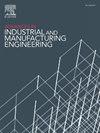电子束-粉末床熔合Ti48Al2Cr2Nb的孔隙缺陷综合分析
IF 6
Q2 ENGINEERING, INDUSTRIAL
Advances in Industrial and Manufacturing Engineering
Pub Date : 2025-08-27
DOI:10.1016/j.aime.2025.100170
引用次数: 0
摘要
研究了电子束-粉末床熔合(PBF-EB)法制备γ -钛铝(Ti-48Al-2Cr-2Nb)零件的工艺-微观结构关系。利用107条工艺参数组合记录,对相对密度、熔合不足(LoF)和气体孔隙度缺陷进行分析和分类。体积密度范围为88% - 99.99%,气体孔隙度范围为0.01% - 0.30%,缺乏熔合缺陷范围为0.001 % - 12%。根据有关通过热等静压可解决的缺陷的文献,确定了四类密度性能:优秀(99.8%),良好(99.6 - 99.8%),差(98.0 - 99.6%)和不合格(98.0%)。为了本研究的目的,高密度的结果(优异级)被认为是理想的,就预期的机械性能而言,特别是强度,疲劳和延展性。孔隙性质根据不同的能量表示进行映射,例如,体积能量密度(VED)和归一化焓(NE)。结果显示了利用NE可视化数据和识别过程参数空间中预期最佳性能的区域的重要性。NE >; 15层的储层预计具有优异的性能,而NE >; 10层的储层预计将产生不可接受的孔隙度。本文章由计算机程序翻译,如有差异,请以英文原文为准。
Comprehensive pore defect analysis for electron beam-powder bed fusion of Ti48Al2Cr2Nb
The process-microstructure relationship of gamma-titanium aluminide (Ti-48Al-2Cr-2Nb) parts fabricated via electron beam-powder bed fusion (PBF-EB) process was investigated. A set of 107 records of process parameter combinations were deployed to analyze and classify relative density, lack-of-fusion (LoF) and Gas porosity defects. The bulk density ranges spanned 88 %–99.99 %, with Gas porosity spanning 0.01 %–0.30 %, and lack-of-fusion defects spanning 0.001 %–12 %. Based on literature pertaining to defects addressable via hot isostatic pressing, four classes of density performance were identified: excellent (>99.8 %), good (99.6–99.8 %), poor (98.0–99.6 %), and failed (<98.0 %). For the purpose of this study, a high density outcome (excellent class) is identified to be ideal in terms of expected mechanical properties, specifically strength, fatigue, and ductility. Pore properties were mapped against different energy representations, for example, volumetric energy density (VED) and normalized enthalpy (NE). The results showed the importance of utilizing NE to visualize data and identify zones in the process parameter space where best performance is expected. A region of NE > 15 is expected to have an excellent performance, whereas NE < 10 is expected to result in unacceptable porosity outcomes.
求助全文
通过发布文献求助,成功后即可免费获取论文全文。
去求助
来源期刊

Advances in Industrial and Manufacturing Engineering
Engineering-Engineering (miscellaneous)
CiteScore
6.60
自引率
0.00%
发文量
31
审稿时长
18 days
 求助内容:
求助内容: 应助结果提醒方式:
应助结果提醒方式:


